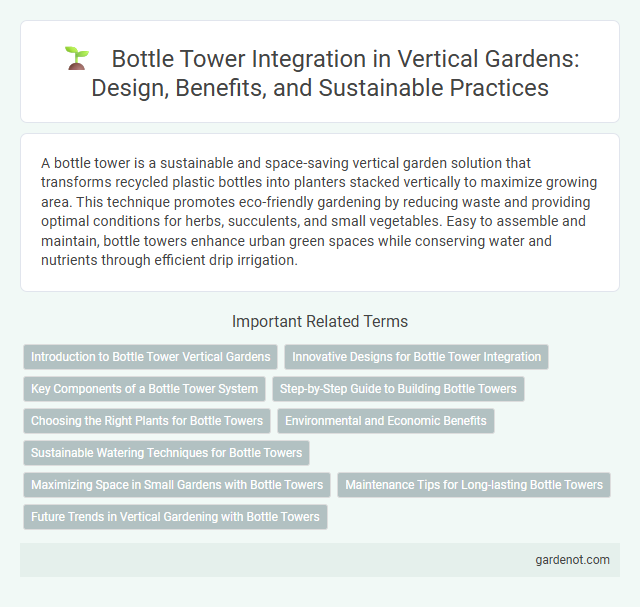A bottle tower is a sustainable and space-saving vertical garden solution that transforms recycled plastic bottles into planters stacked vertically to maximize growing area. This technique promotes eco-friendly gardening by reducing waste and providing optimal conditions for herbs, succulents, and small vegetables. Easy to assemble and maintain, bottle towers enhance urban green spaces while conserving water and nutrients through efficient drip irrigation.
Introduction to Bottle Tower Vertical Gardens
Bottle Tower vertical gardens transform ordinary plastic bottles into sustainable planting units, maximizing green space in urban environments. This innovative gardening method promotes recycling while enabling efficient vertical growth of plants such as herbs, succulents, and small vegetables. Ideal for balconies and small patios, Bottle Towers optimize light exposure and water usage through stacked layers of soil-enriched containers.
Innovative Designs for Bottle Tower Integration
Bottle tower integration in vertical gardens showcases innovative designs that maximize space using recycled plastic bottles as modular planting units. These towers enhance sustainability by combining hydroponic systems with vertical stacking, promoting efficient water usage and root aeration. Advanced designs include customizable bottle arrangements and automated irrigation, optimizing plant growth in urban environments.
Key Components of a Bottle Tower System
A Bottle Tower system primarily consists of vertically stacked plastic bottles that serve as planting containers, optimizing limited space for vertical gardens. Each bottle is modified with drainage holes and filled with a lightweight growing medium such as coconut coir or peat moss to ensure proper aeration and water retention. The structure is supported by a sturdy frame or central pole, providing stability while allowing for efficient water distribution and root growth throughout the tower.
Step-by-Step Guide to Building Bottle Towers
Building a bottle tower for a vertical garden involves collecting clean, empty plastic bottles and cutting them to create planting pockets. Secure the bottles in a sturdy frame or attach them to a wall with strong wire or rope, ensuring proper drainage by adding holes at the bottom of each bottle. Fill each pocket with nutrient-rich soil and select suitable plants, such as herbs or succulents, to maximize growth in the compact vertical space.
Choosing the Right Plants for Bottle Towers
Selecting the appropriate plants for bottle towers involves prioritizing species with shallow root systems and low water requirements, such as succulents, herbs like basil and mint, and small flowering plants like petunias. These plants thrive in compact spaces and limited soil volume, ensuring optimal growth and maintenance within vertical gardens. Proper plant selection enhances vertical garden sustainability, promoting healthy foliage and vibrant blooms throughout the year.
Environmental and Economic Benefits
Bottle towers in vertical gardens significantly reduce plastic waste by repurposing discarded bottles, promoting environmental sustainability and lowering landfill contributions. These structures provide an affordable, space-efficient solution for urban gardening, minimizing the need for costly materials and reducing food expenses through homegrown produce. By combining waste reduction with economic savings, bottle towers offer a practical approach to eco-friendly urban agriculture.
Sustainable Watering Techniques for Bottle Towers
Bottle towers utilize sustainable watering techniques such as drip irrigation systems that minimize water waste by delivering moisture directly to plant roots. The incorporation of recycled plastic bottles creates a self-watering structure that retains and gradually releases water, reducing the need for frequent watering. Innovations in capillary mats and hydrogel pellets within these towers further enhance water retention, supporting efficient plant hydration while conserving resources.
Maximizing Space in Small Gardens with Bottle Towers
Bottle towers transform small gardens by vertically stacking recycled plastic bottles, creating compact, space-saving planters ideal for urban environments. These structures maximize growing areas by enabling multiple plants to flourish in limited ground space while promoting sustainability through upcycling. Efficient water drainage and soil aeration within each bottle enhance plant health, making bottle towers a practical solution for maximizing greenery in tight spaces.
Maintenance Tips for Long-lasting Bottle Towers
Maintaining a bottle tower requires regular watering and ensuring proper drainage to prevent waterlogging and root rot. Periodically checking for pests and removing dead leaves promotes healthy plant growth and longevity. Using nutrient-rich soil and rotating plants based on their light needs enhances the overall vitality of the vertical garden structure.
Future Trends in Vertical Gardening with Bottle Towers
Bottle towers represent an innovative future trend in vertical gardening, combining sustainability with urban agriculture by repurposing plastic bottles as planting containers. These structures optimize limited space and promote eco-friendly practices, supporting biodiversity in urban environments while reducing plastic waste. Advancements in modular design and self-watering systems are expected to enhance their efficiency and scalability in smart city landscapes.
Bottle tower Infographic

 gardenot.com
gardenot.com